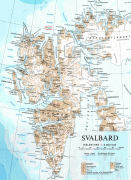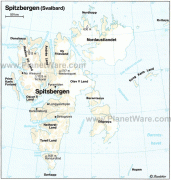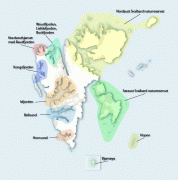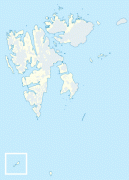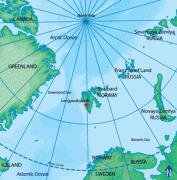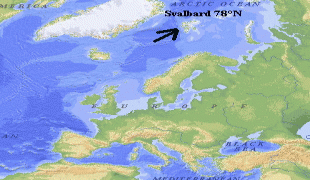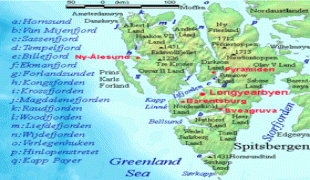Svalbard
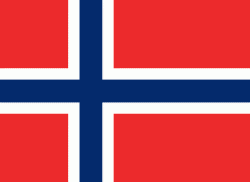 |
 |
Whalers who sailed far north in the 17th and 18th centuries used the islands as a base; subsequently the archipelago was abandoned. Coal mining started at the beginning of the 20th century, and several permanent communities were established. The Svalbard Treaty of 1920 recognizes Norwegian sovereignty, and the Norwegian Svalbard Act of 1925 made Svalbard a full part of the Kingdom of Norway. The Svalbard Treaty established Svalbard as a free economic zone and a demilitarized zone. The Norwegian Store Norske and the Russian Arktikugol remain the only mining companies in place. Research and tourism have become important supplementary industries, with the University Centre in Svalbard and the Svalbard Global Seed Vault playing critical roles in the local economy. Apart from Longyearbyen, other settlements include the Russian mining-community of Barentsburg, the Norwegian research-station of Ny-Ålesund, and the Swedish-Norwegian mining outpost of Sveagruva (which closed in 2020). Other settlements lie farther north, but are populated only by rotating groups of researchers. No roads connect the settlements; instead snowmobiles, aircraft and boats provide inter-settlement transport. Svalbard Airport serves as the main gateway.
Approximately 60% of the archipelago is covered with glaciers, and the islands feature many mountains and fjords. The archipelago has an Arctic climate, although with significantly higher temperatures than other areas at the same latitude. The flora has adapted to take advantage of the long period of midnight sun to compensate for the polar night. Many seabirds use Svalbard as a breeding ground, and it is home to polar bears, reindeer, the Arctic fox, and certain marine mammals. Seven national parks and 23 nature-reserves cover two-thirds of the archipelago, protecting the largely untouched fragile environment.
While part of the Kingdom of Norway since 1925, Svalbard is not part of geographical Norway; administratively, the archipelago is not part of any Norwegian county, but forms an unincorporated area. This means that it is administered directly by the Norwegian government through an appointed governor, and is a special jurisdiction subject to the Svalbard Treaty that is outside of the Schengen Area, the Nordic Passport Union, and the European Economic Area. Svalbard and Jan Mayen are collectively assigned the ISO 3166-1 alpha-2 country-code "SJ". Both areas are administered by Norway, though they are separated by a distance of over 950 km and have very different administrative structures.
The name Svalbard was officially adopted for the archipelago by Norway under the 1925 Svalbard Act which formally annexed it. The former name Spitsbergen was thenceforth restricted to the main island. In 1827 Baltazar Keilhau first proposed that the Old Norse toponym Svalbarði, found in medieval Icelandic sources, referred to Spitsbergen. Keilhau's theory was revived by Gustav Storm in 1890 and Gunnar Isachsen in 1907, at a time when ancient Norse connection to the land would help modern Norway's contested claim to sovereignty. Svalbard is a modern Norwegian analogue of Svalbarði, which in turn derives from svalr ('cold') and barð ('edge', 'ridge', 'turf', 'beard'). The Icelandic Annals record that Svalbarði was discovered in 1194, while the Landnámabók places it four dægrs' sailing north of Langanes. The word "day" might mean either 12 or 24 hours; Isachsen took the latter interpretation, thus discounting Jan Mayen as Svalbarði. Cultural studies academic Roald Berg says Svalbarði more likely referred to part of Greenland, and the 1925 renaming cemented Norwegian sovereignty as recognised by the 1920 Spitsbergen Treaty (now the Svalbard Treaty).
The name Spitsbergen originated with Dutch navigator and explorer Willem Barentsz, who in 1596 described the "pointed mountains" or, in Dutch, spitse bergen that he saw on the west coast of the main island. Barentsz did not recognize that he had discovered an archipelago, and consequently the name Spitsbergen long remained in use both for the main island and for the archipelago as a whole. Later the main island was sometimes distinguished as West Spitsbergen. The spelling Spitzbergen, with z instead of s, derives from German.
Map - Svalbard
Map
Country - Svalbard_and_Jan_Mayen
Svalbard and Jan Mayen (Svalbard og Jan Mayen, ISO 3166-1 alpha-2: SJ, ISO 3166-1 alpha-3: SJM, ISO 3166-1 numeric: 744) is a statistical designation defined by ISO 3166-1 for a collective grouping of two remote jurisdictions of Norway: Svalbard and Jan Mayen. While the two are combined for the purposes of the International Organization for Standardization (ISO) category, they are not administratively related. This has further resulted in the country code top-level domain .sj being issued for Svalbard and Jan Mayen, and ISO 3166-2:SJ. The United Nations Statistics Division also uses this code, but has named it the Svalbard and Jan Mayen Islands.
Svalbard is an archipelago in the Arctic Ocean under the sovereignty of Norway, but is subject to the special status granted by the Svalbard Treaty. Jan Mayen is a remote island in the Arctic Ocean; it has no permanent population and is administered by the County Governor of Nordland. Svalbard and Jan Mayen have in common that they are the only integrated parts of Norway not allocated to counties.
Svalbard is an archipelago in the Arctic Ocean under the sovereignty of Norway, but is subject to the special status granted by the Svalbard Treaty. Jan Mayen is a remote island in the Arctic Ocean; it has no permanent population and is administered by the County Governor of Nordland. Svalbard and Jan Mayen have in common that they are the only integrated parts of Norway not allocated to counties.
Currency / Language
| ISO | Language |
|---|---|
| NO | Norwegian language |
| RU | Russian language |







